This post may contain affiliate links. We may receive a small commission, at no cost to you, if you make a purchase. Read Disclosure.
Ahh Africa, there’s no place on earth like it. It’s a continent famous for its vast, unspoiled landscapes, where scotching deserts, barren plains, and untamed grasslands collide and where animals roam freely.
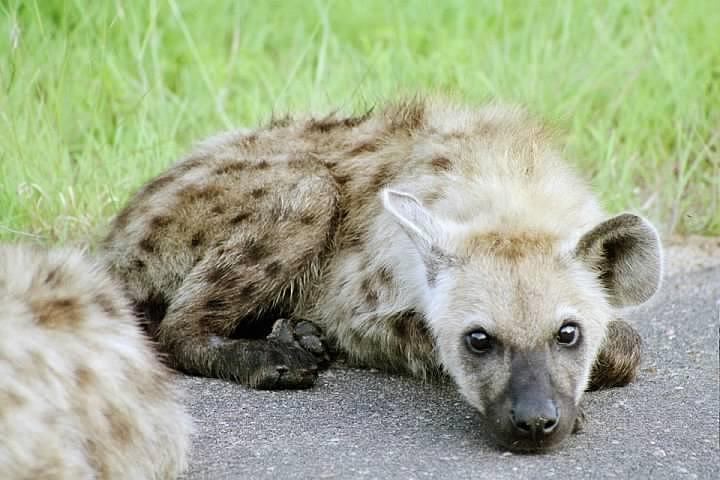
If you’re an animal lover and want to see some of the world’s most majestic creatures up close, then a visit to an African Game Reserve should be high on your bucket list.
But Africa isn’t exactly small. It’s a continent that spans 30.37 million km² and contains 54 countries, so picking the best place to visit to see animals is not an easy task.
To help you narrow down your choices, we have put together a list of the best game reserves and safari parks in Africa, and why they are the best.
Most of the safari opportunities are located in Southern and East African countries, but each destination offers something special and unique. So, if you’re not sure where to go, keep reading to find out.
What Is The Big Five In Africa?

There is estimated to be more than 1,100 animal species in Africa, from carnivorous predators to endangered insects.
When visiting Africa, you will hear the term “The Big 5” used a lot. This is a term used to describe Africa’s five most difficult to hunt animals – lions, rhinos, elephants, leopards and cape buffalo.
When embarking on a safari in Africa, it’s quite common to hear tour companies selling the chance to see “The Big Five” in their natural habitat, and if you do see all five, then that’s certainly a bucket list dream achieved!
Seeing the Big 5 has been a travel bucket list ever since I was a child, but besides seeing the big cats and rhinos, I love elephants and can spend hours watching them in their family units and learning so much from them.
They are some of the wisest animal species on our planet and even as you watch them from an open air jeep, you can tell that each one has its own personality.
Aside from The Big 5, you can also see zebras, giraffes, cheetahs, boar, hyena, and if you’re really lucky, a pack of African wild dogs.
Difference Between A Game Reserve & National Reserve
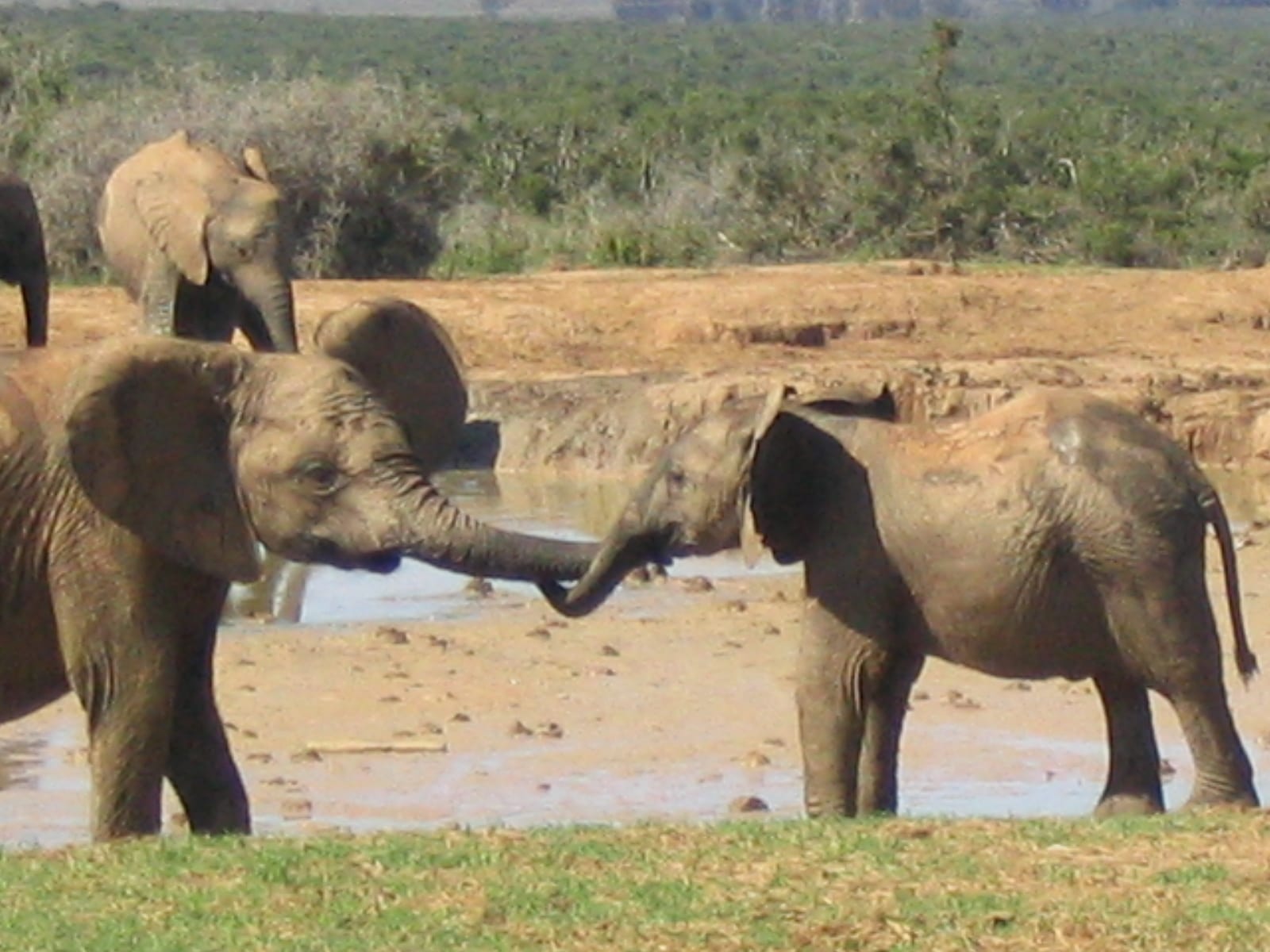
Before booking a safari in Africa, you should understand the difference between game reserves, national parks, and national reserves.
Here is a brief definition of each type of reserve you’ll find in Africa:
- Game Reserve: A game reserve is land owned and maintained by those who reside within it. Most game reserves are private game reserves, which are usually owned by a company, a group of animal loving people, or a family. In South Africa, it’s common that farmers turn some of their land into game reserves, as it brings income through tourism.
- National Parks: this is land owned and managed by the government and has been listed as protected area.
- National Reserve: land that has been designated as environmental conservation areas.
Should You Self Drive In A Game Reserve?
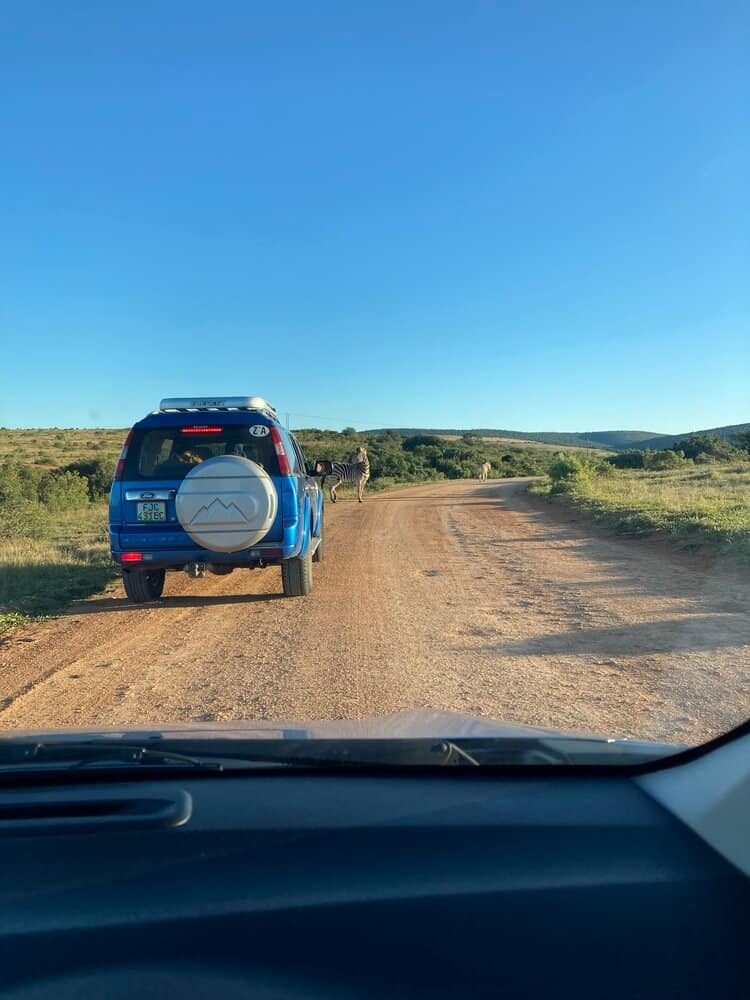
Most game reserves are open to the public and allow you to drive yourself. This is a more cost-effective way of seeing a game reserve since you don’t have to pay for a tour guide and jeep.
However, we highly advise you book a tour over self-driving, for the following reasons:
- You can see more in a jeep. In a hire car, you are very low to the ground and the grass is often higher than your vehicle, which means less visibility.
- You potentially see more animals. Your guide will be connected to other guides via walkie-talkie, and they constantly communicate when they see animals that are rare to spot, such as leopards, cheetahs and rhinos. Having a guide is not about learning about the animals, but learning how to find them.
- You can sit back and relax without worrying. Being in the hands of someone else means you can sit back and relax and concentrate on enjoying the experience. When you are driving yourself, you are responsible for stopping and looking for animals.
- It’s safer. These are wild animals and you are in their home. If an elephant charges at you, then you will have a better chance at escaping in a 4×4 jeep than a rental Renault Clio. Not to mention the guides know what to do should an animal get too close. They also know the warning signs that animals give when they want space.
- You don’t know what you’re looking for. When you drive yourself, it’s a game of luck. Most of travelers are not trackers or wildlife experts, and can’t recognise the signs of recent animal activity. On a guided tour, you will have a professional tracker who looks at broken branches, foot prints, disturbed rocks, and can tell when an animal has been and how long ago.
- You can meet other people. This is luck of the draw. We have done game drives with people who have not stopped talking and it ruined the experience, or we have met other likeminded people to share in this awe-inspiring experience. If you’re traveling alone, this is definitely a plus.
- Best way to see rhinos. Most national parks have a map at the entrance with markers showing where recent animal sightings have been. This makes it easier for self drivers to figure out where to go to see lions, leopards, elephants etc. But because rhinos are still being poached, they don’t map out their location (for obvious reasons). Therefore if you want to see rhinos, you need to have a professional tracker with you, or someone who saw one recently – aka, a tour guide. Or just pray to the Gods, it’s really all about luck.
The Best African Game Reserves & Safari Parks to Visit in Africa
There are numerous safari game parks in Africa. But I recommend you select only those you most want to see and that suits your budget, the animals that are present, and the season in which you are traveling.
Here are four safari game parks that we personally visited.
1. Maasai Mara National Reserve
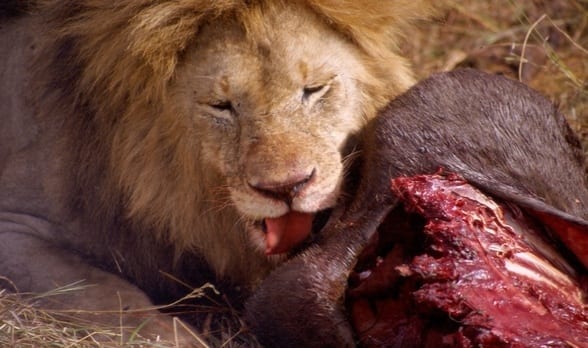
The Masai Mara National Reserve, also sometimes spelled Maasai Mara National Rserve, is located in Southwest Kenya, and is a huge expanse of savannah wilderness covering around 1510 square kilometers.
It’s one of the most famous national parks in Africa because it’s where the annual Great Migration happens. This is when the world’s largest population of wildebeest, zebras, gazelle and other animals (around 2 million animals in total) migrate in a clockwise direction across the Serengeti in Tanzania and Masai Mara.
It’s known for its big cat population (due to the large amount of prey) and is one of the best places to see lions, cheetah and leopards.
This was the first safari game park we visited and so has the “first love” attachment for me. The memory of riding through the savannah in an open topped van is still strong in my mind.
Experiencing the plains dotted far and wide with zebra and wildebeest; giraffes loping by in the distance, stopping for lunch under the shade of an acacia; watching cheetahs on the hunt and seeing my first ever lion kill of a wildebeest in front of us will never leave me.
And then at night, we camped with the Masai people. We sat around the fire talking to a Masai warrior as he shared tales with us of life as a fierce nomadic warrior who fight lions and leopards with their bare hands.
The Masai Mara is approximately 280 kms west from Nairobi City and driving will take you about 5-6 hours. You can self-drive in Masai Mara Game Park but it’s always recommended to go with a guide.
2. Etosha National Park, Namibia
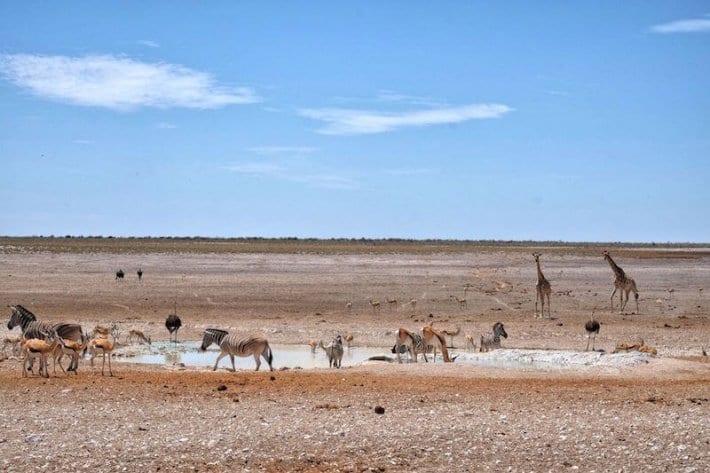
Etosha, meaning “Great White Place,”is dominated by a massive dry salt pan which fills only if the rains are heavy and even then only holds water for a short time. It’s a huge national reserve, covering an area of 22,270 square kilometers.
This temporary water in the Etosha Pan attracts impressive flocks of flamingos and the perennial springs along the edges of the Etosha Pan draw large concentrations of wildlife and birds.
Etosha National Park is one of those parks that’s best visited at night. It’s well known for it’s lively activity at night time around the waterholes.
We unfortunately went during the wrong season, the rainy season, with the best time being from May to September.
We didn’t see much as the animals had ample watering holes elsewhere in the park, so didn’t need to come to the floodlit ones near our camp.
We did, however, see a lot of animals during the day.
As a visitor to Etosha you can expect to see many buck species, elephant, giraffe, rhino and lions, there is a network of roads linking the three campsites and subsidiary roads lead to various waterholes.
Etosha is approximately 6 hours drive from Windhoek and is one of the best places to visit in Namibia. The road is good tarmac and can easily be driven in one day.
3. Kruger National Park, South Africa
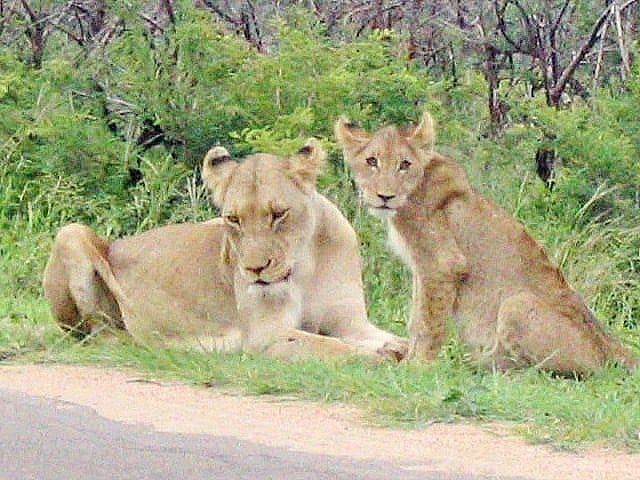
The iconic Kruger National Park is the most well known safari park to visit in South Africa, and definitely one of the best in South Africa for wildlife viewing.
It boasts the most diverse game viewing experience in Africa and is the largest national park in SA at an area that spans 18,485 square kilometers – for perspective, it’s almost the same size as Wales (the country).
What’s unique about Kruger is that you can stay at luxury accommodation inside the park such as 5* lodge hotels, or find budget accommodation outside the park. You can even play golf inside the park, where hippos bathe in the waters of the lake in the middle of the course (I’m not kidding).
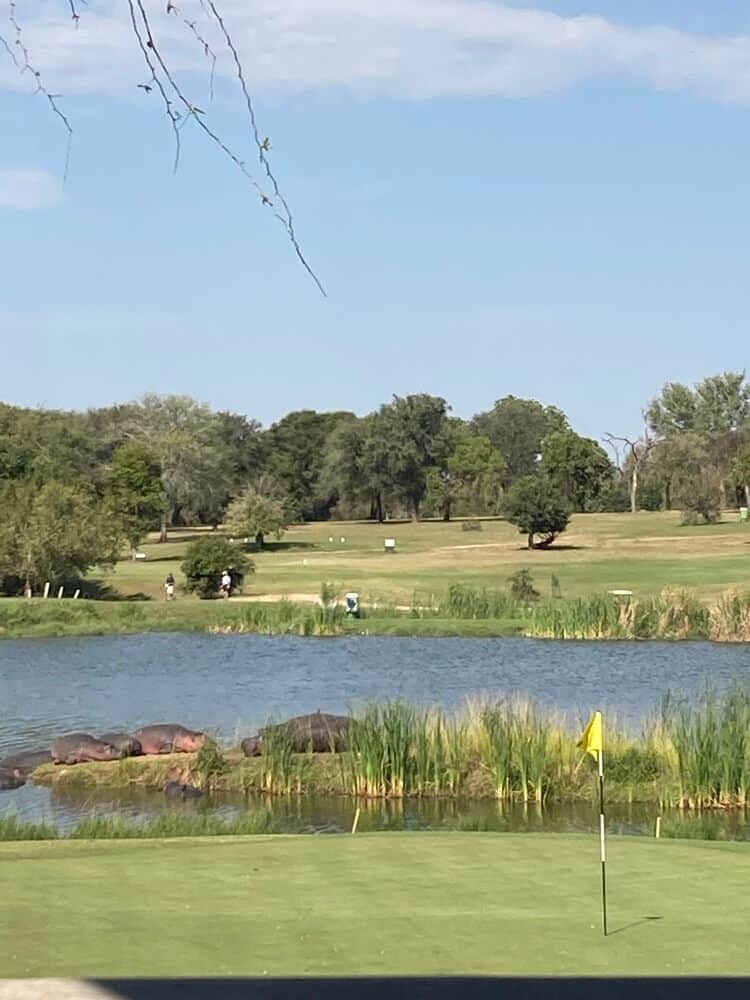
For that reason, no national park anywhere in the world can match what Kruger National Park has to offer.
Aside from the resorts, Kruger is abundant in wildlife. It has an extensive and developed road system, which means it’s easy to self drive with a rental car.
After several months of trying to find the elusive leopard, we finally saw one in Kruger sleeping in a tree and another stalking off into the bushes.
The park is massive, as are most national parks in Africa, so we highly recommend getting a guided tour so you have a driver taking you to the most active spots.
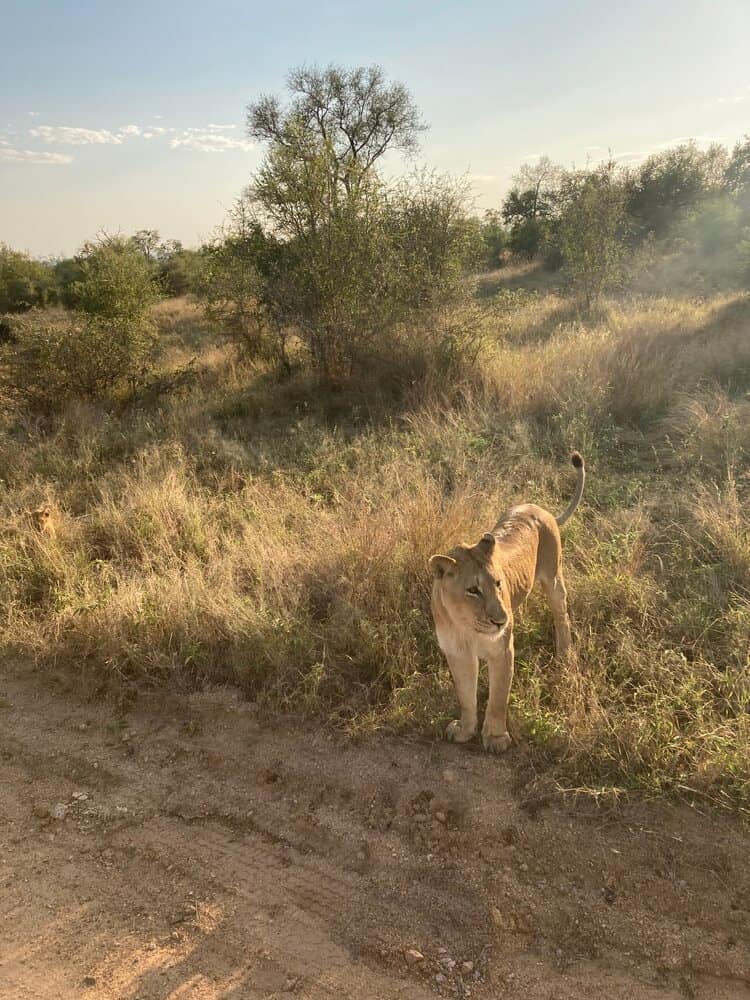
For self drivers, will have to choose carefully as to where you will spend the majority of your time. Don’t try to see too much. Stick to one pocket and use that as a base to explore.
The South is best to visit for big cats around Camp Shawu, though most people visit Skukuza which is roughly in the center and offers a great base to see the Big 5.
Our favorite area of Kruger was around the Lower Sabie Rest Camp on the banks of the Sabie River, in the Sabi Sands Game Reserve, which draws a wide variety of animals all year round.
Also, make sure you leave room in your budget for a night time drive and a guided safari walk, which is an exhilarating experience. You can stand up wind from wild rhinos grazing, and stand where lions have just been – experiencing instead the lingering trace of their pungent smell.
To get there, you can fly direct into Johannesburg and drive 4 hours to Kruger, or you can fly into Kruger Mpumalanga International Airport (KMIA) or Hoedspruit Eastgate Airport (HDS), though this is more expensive.
4. Addo Elephant Park, South Africa
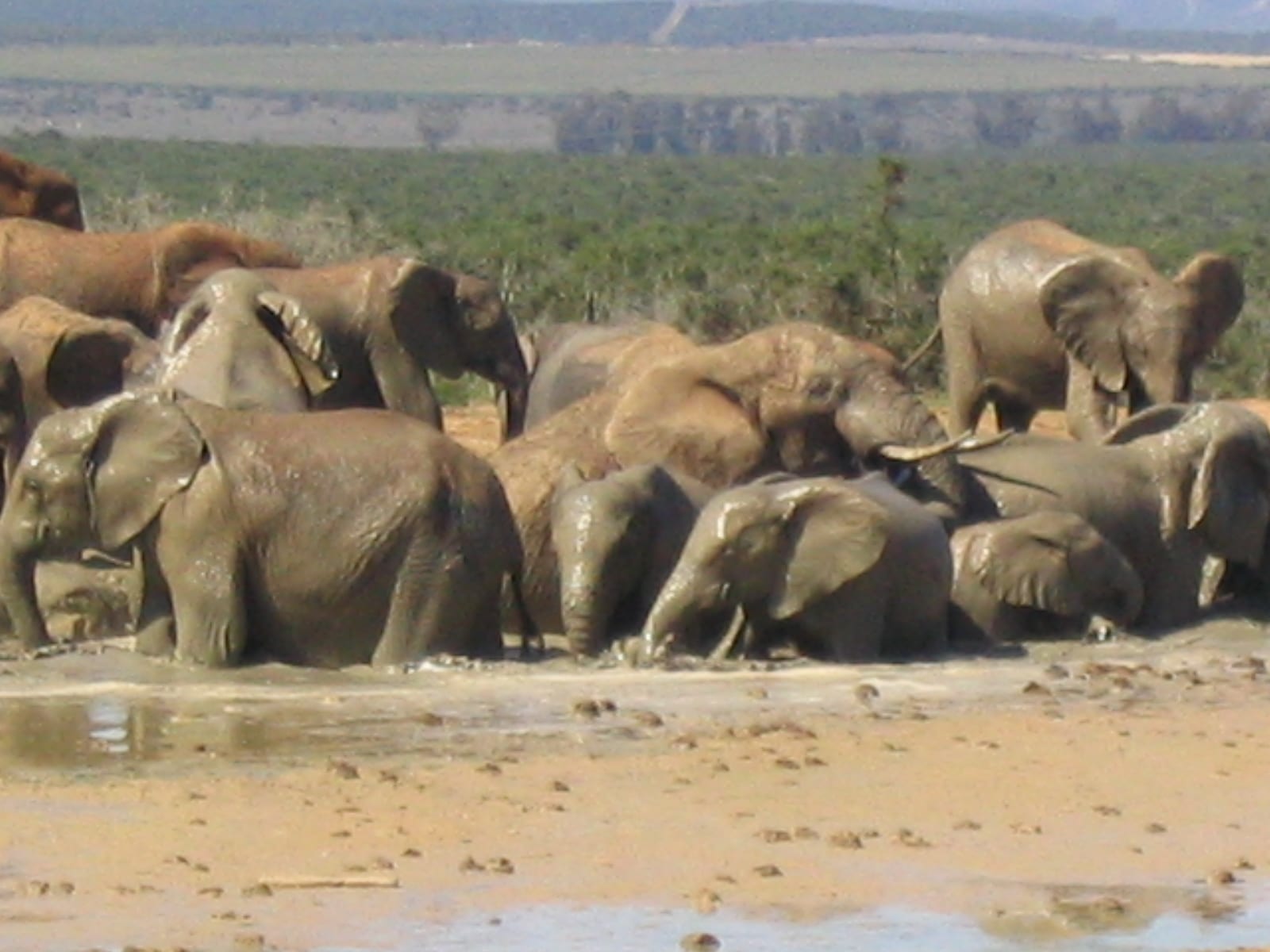
Addo Elephant Park, located about 75km from Port Elisabeth, was one of my favorite African safari parks and one that was totally unexpected.
If you want to have incredible experiences with elephants, then this is the place for you.
Addo is a sanctuary to over 550 elephants, lions, buffalo, black rhino, spotted hyena, leopard, a variety of antelope and zebra species, as well as the unique Addo flightless dung beetle, found almost exclusively in Addo.
We didn’t see any giraffes or rhino there on our visit.
What people do come for, as you may guess from the name, is elephants. You will come across hundreds of them as families gather together by the waterholes for their daily mud baths.
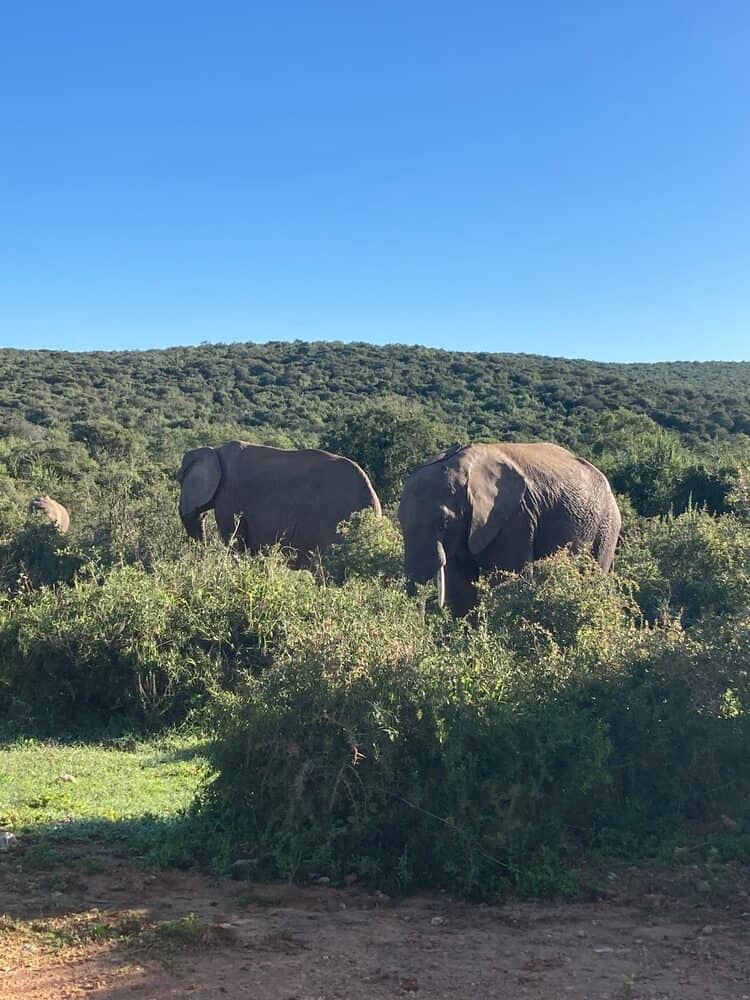
The huge gathering of elephants at the mud bath is a highlight of a visit to this park. They are usually located to the north of the park where the landscape is more open.
The south is bushland and has tall grass, which is said to be where the big cats like to roam, but we didn’t see much wildlife in this area – though it’s better to enter through the South and drive North, as it’s closer to Port Elizabeth this way.
The nearest city to Addo Elephant Park is Port Elizabeth, which is 75km from the park. You can hire a car from PE Airport and drive to the South Entrance within 30 minutes.
Travelling time from Cape Town to the park by vehicle is approximately 9 hours, so we recommend you stay two nights in Port Elizabeth so you can spend a full day here.
5. Volcanoes National Park, Rwanda
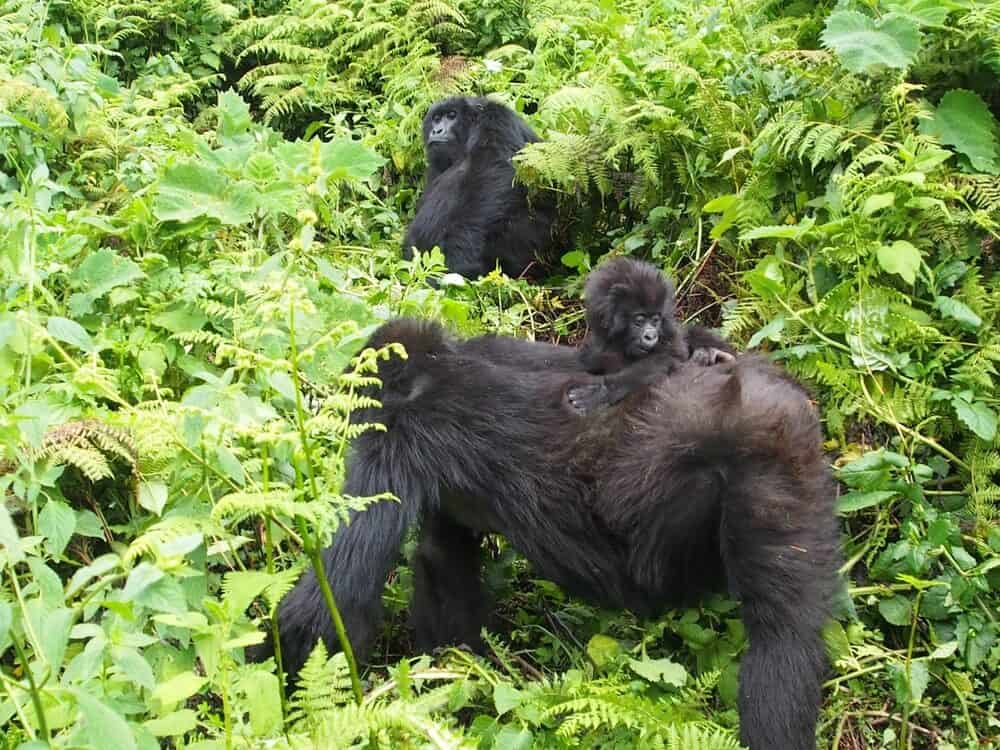
Volcanoes National Park in Rwanda is a huge area that spans for approximately 523 square miles, and is known for its breathtaking volcanic landscapes and its contributions to preserving endangered mountain gorillas.
What makes Volcanoes National Park truly special is its role as a sanctuary for these magnificent creatures. It is home to more than half of the world’s remaining mountain gorilla population, making it a crucial conservation area.
It’s one of the few places in the world where you have the rare opportunity to observe these gentle giants in their natural habitat, which is certainly a bucket list experience.
In addition to mountain gorillas, the park boasts incredible biodiversity, with over 200 bird species and other mammals like golden monkeys, buffalos, and elephants. The lush greenery, mist-covered volcanoes, and stunning views make Volcanoes National Park a once-in-a-lifetime experience.
It’s best to visit the park on one of the famous Gorilla Treks, which take you through dense forests, guided by experienced trackers, where you can find gorilla families in their natural home.
The trek can be physically challenging, and you can trek for one hour or eight hours, as long as it takes to find the gorillas, but it will certainly be rewarding once you come in close proximity to these gentle giants.
6. Serengeti National Park, Tanzania
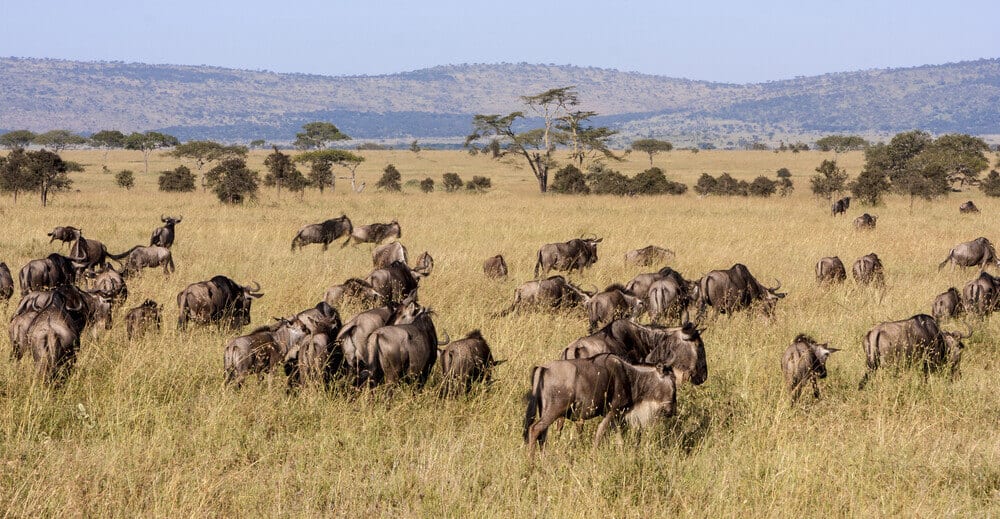
Serengeti National Park is perhaps the most famous safari park in Africa. It’s located in Tanzania, known as one of the best African countries to view wildlife.
The park spans a sprawling area of approximately 14,750 square kilometers and is where the annual Great Migration passes through. Visit from July through November to see millions of wildebeest and other herbivores traverse the plains in search of greener pastures.
Visiting Serengeti National Park is where you can witness the true circle of life unfold before your eyes. It’s a chance to see migrating herds, lions, cheetahs, leopards, elephants, giraffes, zebras, and numerous bird species.
Another popular game reserve in Tanzania that’s worth visiting if you have time is Ngorongoro Conservation Area, which is home to the Big 5 and also gets visited by the Great Migration of wildebeest.
7. Moremi Game Reserve, Botswana
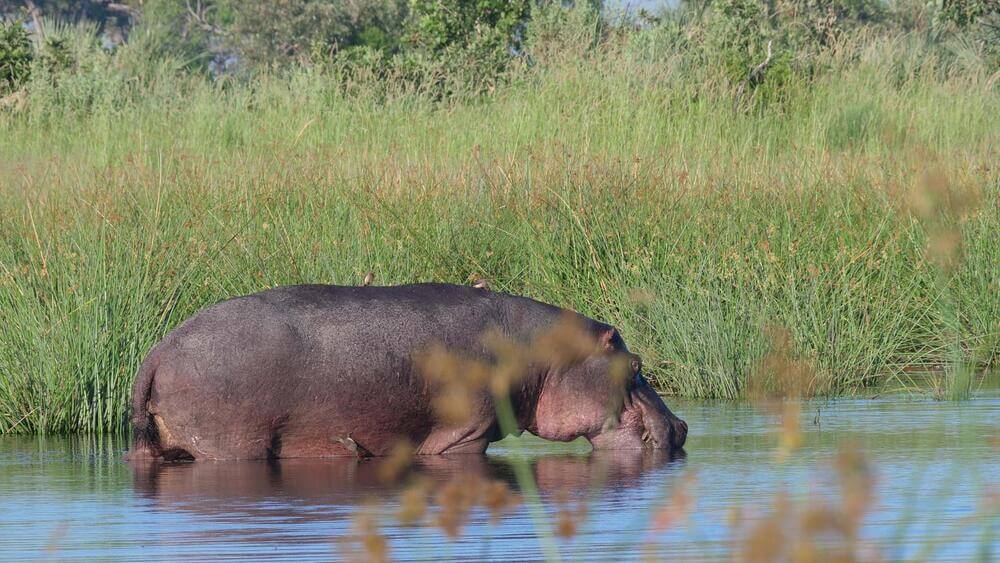
Moremi Game Reserve is a smaller game reserve, covering just 5,000 square kilometers, which has a diverse ecosystem – ranging from vast floodplains to dense forests, which are home to a wide array of animals.
The reserve offers a chance to see The Big 5, as well as giraffes, zebras, and countless bird species. All animals are free to roam at their leisure, but because it’s a small park, game drives and boat safaris allow visitors to spot wildlife up close.
Exploring Moremi Game Reserve is like stepping into the pages of a wildlife documentary. Moremi Game Reserve is not only a chance to witness Africa’s most majestic creatures, but experience the untouched natural beauty of the Okavango Delta
Some other popular game reserves in Botswana include the Chobe National Park and Kgalagadi Transfrontier Park. Check out these things to do in Botswana.
8. South Luangwa National Park, Zambia

South Luangwa National Park in Zambia is a 9,050 square kilometer park that is truly untouched wilderness.
The park is renowned for its walking safaris, where you can explore the African bush on foot and experience an intimate connection with nature. It is also home to an impressive array of wildlife, including elephants, lions, leopards, hippos, crocodiles, and over 400 different bird species.
Visiting South Luangwa National Park is an immersive adventure and one of the best ways to learn more about the African wild. Don’t miss out on a chance to enjoy a night drive to reveal the park’s nocturnal wonders.
Tips for The Best Wildlife Encounters in Africa
1. Plan in Advance
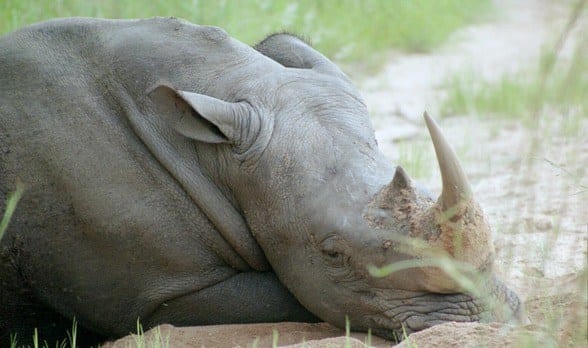
Decide what animals you want to see, as some animals are only found in certain parks.
Going to many different parks all over the continent will cost you. So prioritize and go for the game parks that will allow you to see the greatest variety of wildlife.
2. Know Which Season is Best for Wildlife Viewing in Africa
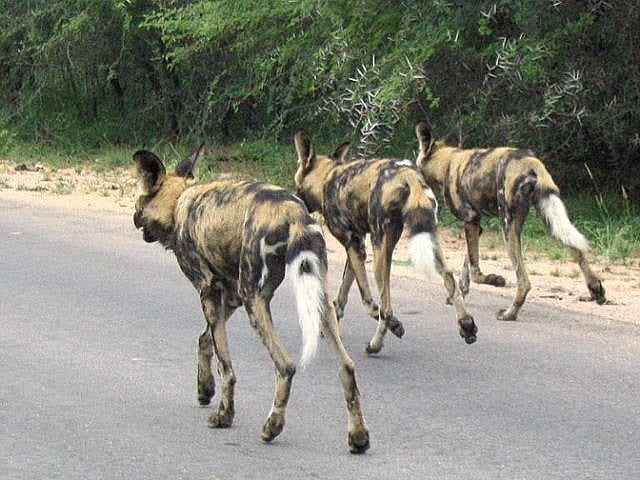
The best season to see animals in Africa is in the dry season (June to October). The grass is short making it easier to spot wildlife.
Also, choice of drinking water holes for the animals will be fewer so they are moving around more in search of water so your chances of watching them socialise at waterholes is greater.
So find yourself a water hole and chances are you will have some company.
In the wet season, the grass is long making viewing more difficult and they have many options for water holes so don’t need to roam as much.
3. Know The Best Time of Day for Animal Viewing
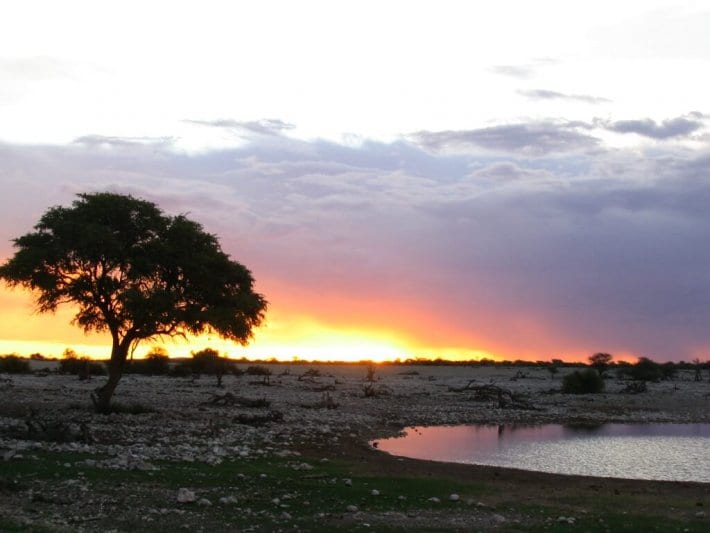
Animals are most active at dusk and dawn when they are out hunting for food. It is very hot in Africa, so during the day the animals are usually hibernating in the shade.
Be sure to do the same thing yourself. If your excitement is too hard to contain and you go out during the day, the only result will be that you chew up your fuel budget, and an eventual visit to the chiropractor for neck strain.
Get up real early to catch the animals at play, rest during the day, and then go out again just before sundown.
HOT TIP: Lions like to sleep on the road at night to soak up the day’s heat trapped in the tar. If you’re up early enough you can usually run into one on the road. There were several times we turned a corner to find a lioness resting on the warm tar.
4. Take a Guided Night Drive
In Kruger Park you can only go on night drives organized at your accommodation. All gates to accommodations close by nightfall and you better be locked safe and sound inside them.
Once night falls you can jump in an open topped vehicle with a huge spot light and a guide to tell you more about what you see as you drive around the park, hearing the sounds and seeing the sites of nighttime Africa.
5. Go on a Guided Walking Safari
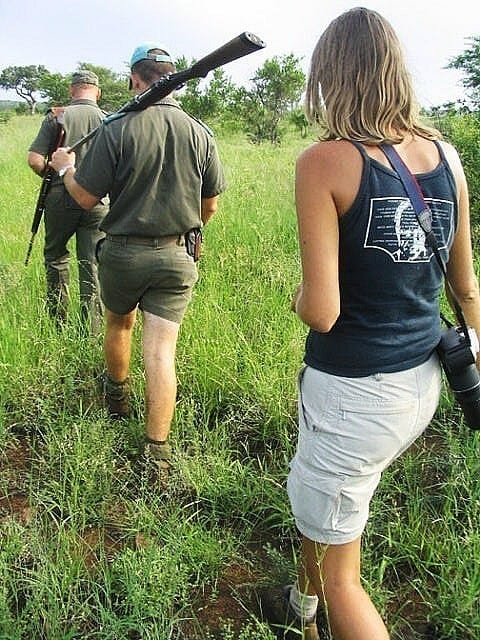
You can do this in Kruger Park also. Getting on the ground with these magnificent beasts in their territory will get your heart pumping.
We didn’t have as much action as anticipated, but we did get close to rhinos (downwind) and we smelled the fear of the lions running away from us in the distance.
6. Tips for Wildlife Photography
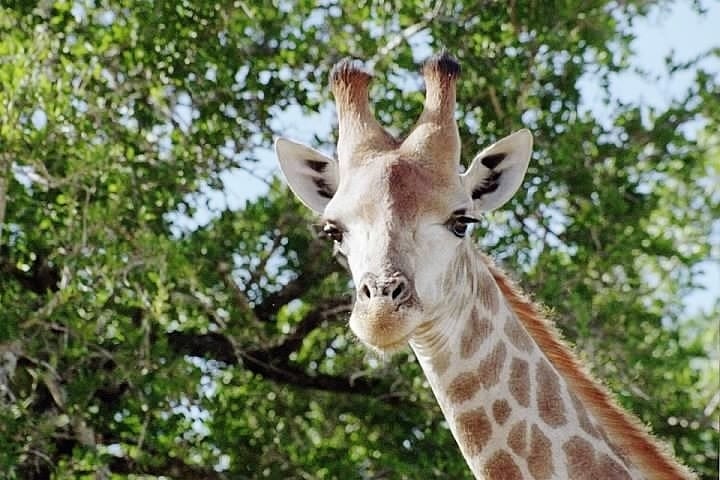
Be patient and remember that spotting your favorite animals can take time.
Spend the money to buy a good lens, at the very minimum a 300mm zoom but preferably a 600mm zoom lens. Animals are scared of you, they won’t come close for a portrait, and you won’t sneak up closer to them (I hope).
You’ve spent all the money, time, and energy to put yourself in a place of contact with these wild animals, you want to have something to take away from it and keep with you for memories and reflection.
7. Follow The Safety Advice in Safari Parks
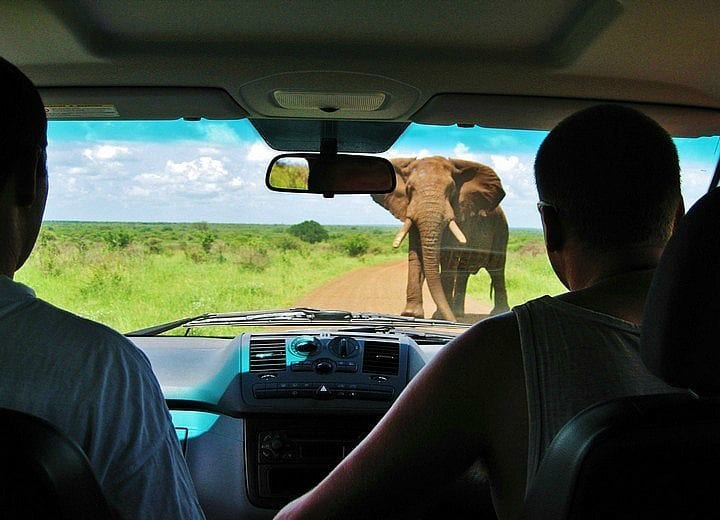
Never ever ever, and I mean ever get out of your car, unless in a safe designated area, or with an armed ranger present.
This is the wild, don’t mess with it. Even in private game reserves, animals roam freely and the land is considered theirs.
I know this sounds a bit like a ‘No sh*t, Sherlock’ kind of statement, but you will be surprised at how many people get eaten by lions trying to get that perfect shot.
Keep a safe distance when you encounter a wild animal and when in your vehicle keep your windows rolled up.
And please don’t lean too far out of the jeep to get a photo!
8. Get Vaccinated
Visit your local doctor and talk about vaccinations and medicines to take. Very few national parks and game reserves are malaria-free, other than Pilanesberg in South Africa.
After choosing which parks you want to go to, speak to your doctor about what you need.
Final Thoughts
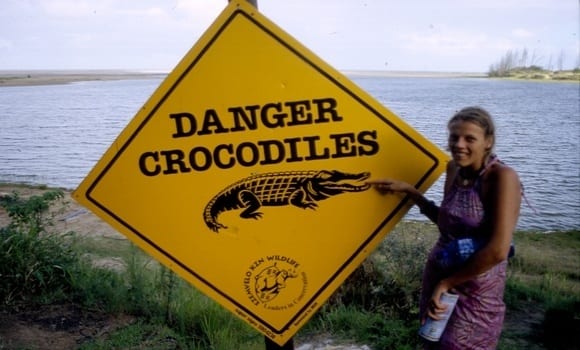
For many, the thought of traveling to Africa is enough to send them scurrying under their bed with fear. It’s wild, remote, and untamed, and that can send the fear of God into some people.
But you’ll soon learn there’s nothing to fear, only to be enjoyed, if you follow our Africa travel safety tips.
It’s also worth noting that a safari is by no means a budget experience. Even when yourself drive, the cost of hiring a car and paying entrance fees adds up, so if you want to travel Africa on a budget, then know that you will need to set aside funds for this experience.
Getting around East and South Africa for your wildlife viewing does come at a price, but there are many transportation options to suit each traveler’s budget, desired experiences and comfort levels.
If you’re considering joining a group tour for Africa, consider our long-term partner Globus family of brands. We have a discount in the blue box below.
GLOBUS DISCOUNT JUST FOR YOU!
We’ve secured an exclusive yTravel discount: Save $100 per person on select 2024 Globus and Avalon Waterway Vacations. Use the code: YTRAVEL when booking online at the Globus, Cosmos, and Avalon Waterways websites, by calling Globus and Avalon Waterways directly, or booking with a preferred Travel Advisor. Terms & Conditions.
Now it’s your turn! Have you been to Africa on a safari? What are your tips and most memorable moments? Let us know in the comments.